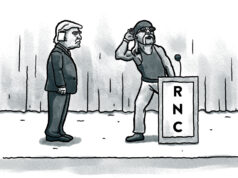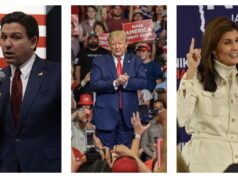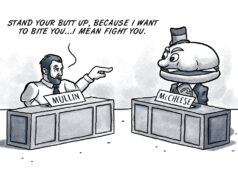
When any tweet linking a story scrolls across my screen with words like “Trump” “Sanders” or “anchor baby,” the political junkie in me can’t resist.
With the 2016 presidential campaign cycle revving up, stories about surprise trends and dark-horse candidates will naturally follow. H.A. Goodman wrote an interesting piece Tuesday on Huffington Post claiming Sen. Bernie Sanders will beat former Secretary of State Hillary Clinton for the Democratic Nomination because of “polling trajectory.”
Even with Clinton’s increasingly baffling e-mail-related political face plant, Goodman’s thesis is a bold one. His intriguing argument is grounded in some analysis of a variety of public opinion polls. But numbers in presidential polls can come from many different places and represent many different things, so which voters these polls were asking questions of tells a different story.
According to HuffPost Pollster, Clinton’s lead over Sanders among Democrats was an astounding 60.1 percent to a mere 4.9 percent on March 2, 2015. By August 26, 2015 Bernie Sanders surged all the way to 23.4 percent while Clinton fell to 47.1 percent.
First, the HuffPost Pollster aggregates only national polls rather than polls that would be more supportive of a “Sanders will win” argument: swing-state or early-primary-state polling of Democrats only. National polls will become somewhat relevant and insightful by October 2016, in the home stretch of the general election. But even then, the more crucial statistical indicator of who will win the White House is the aggregate of polling data in the handful of electoral college swing states.
You know the names: Ohio, Florida, Nevada. National polls in really any scenario are a snapshot of roughly 700 to 1,000 voter opinions representing both states that are part of the electoral college road map, and state’s like Oklahoma where results are foregone conclusions with no impact on the swing-state attrition game. A GOP voter in Oklahoma saying he or she would never vote for Hillary Clinton and a Democratic voter in California saying the same about Donald Trump skew the overall results and don’t indicate any predictive value as to who will likely accumulate the magical 270 electoral college votes needed to hold the most thankless job in this nation.
Later in his piece, Goodman does turn toward what appears to be more compelling and relevant data. In key states early in the nominating process like New Hampshire (just next door to Sanders’ home state of Vermont), Clinton shows considerable weakness to pair with strong “feel the Bern” momentum.
But it is important to remember Clinton won big in New Hampshire in 2008 just days after Obama’s big win in Iowa. The Clinton money machine — both within her campaign and with the super PACs supporting her — will be stout, even with her e-mail concerns not going away. Clinton donors are loyal to the end. Furthermore, her team has not begun negative pushback against Sanders, a candidate easily depicted as an unelectable “socialist” choice because, well, he calls himself a socialist.
This will be an effective tactic on some Democratic voters who may even prefer his politics but find their more pragmatic inner compass awakened as they consider going with a safer choice in order to avoid losing the White House. For all we know, the safe choice may be a future Vice President Joe Biden candidacy, compared to the perceived risk posed by Clinton.
Here is another example from Goodman’s piece where it is tempting to extract intriguing numbers to fit an argument without a full understanding of how those metrics are relevant to the electoral process that will play out over the coming 14 months:
(…) swing state voters do not trust Hillary Clinton according to CNN. An August 20th Quinnipiac University Poll confirms this claim and found that voters in Florida, Ohio, and Pennsylvania do not find Hillary Clinton honest or trustworthy. In fact,Quinnipiac University states “Clinton and Trump have the worst overall favorability ratings among all voters of any of the leading candidates, and the lowest scores for being honest and trustworthy.
Goodman is accurate that this is very valuable voter sentiment to consider when analyzing electability. But, yet again, it is important to dig deeper into the data and see to whom Quinnipiac was talking.
Quinnipiac polls voters from both parties in these states. It is not clear on question number 46 from the poll — the honesty/trustworthy issue Goodman points to — if the respondents were just Democrats or also Republicans. If her poor numbers here were just with Democrats, that metric is relevant to swing-state democratic electorates, in this case Florida, Ohio and Pennsylvania. Florida and Ohio hold their primaries on March 15, which means 21 states vote before they do. Pennsylvania’s primary is set for April 26, which means 31 states will vote prior.
Waves of momentum and crisis will rise and fall over these remaining weeks. Negative ads and candidate goofs will factor into primary voters’ discerning opinions, especially those more pragmatic voters who begin to pay attention in January. In this scenario of only Democrats being polled, the low trust metric toward Clinton is relevant, but not terribly so at this point in the campaign.
But question 46 could have polled both Democrats and Republicans, and in that case these “general election” views have even less relevance to Goodman’s argument about Sanders’ trending polling. A republican voter’s view of Clinton won’t factor into Democratic primary voter decisions at the ballot box. Quinnipiac chose those three states to poll because they will likely be huge deciding battlegrounds for the White House in the general election. It was conducted to project sentiments out to that later stage in the campaign season.
It could be an important dynamic in the more pragmatic and strategic decisions the campaigns will subtly tell voters to make: electability. This becomes important to voters over time: many may like things about both candidates (Clinton is a woman, Sanders is a populist), but who gives the Democratic Party the best chance at winning will begin to have a larger influence on voter preference.
Goodman makes a strong case that Hillary Clinton’s negatives are rising, and that Sanders has strong support from an important chunk of Democratic primary voters. However, when he predicts Sanders will top her for the nomination, the presidential polls he sources as support do not provide the relevant data to support such a bold prediction at this time.





















